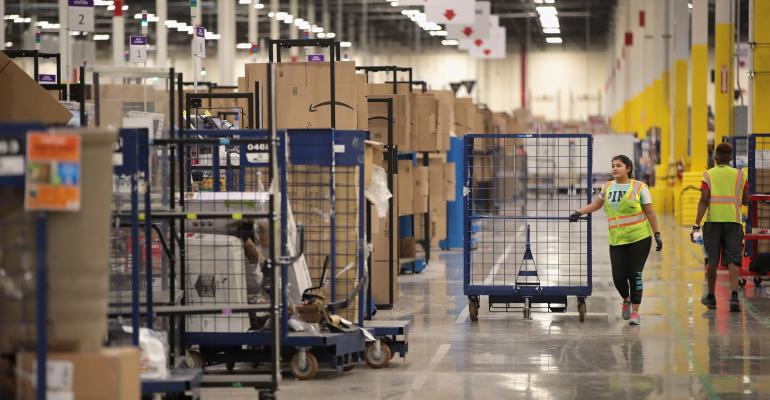With online retail sales rising by 10 percent annually, the volume of returns is also growing. According to research from market data firm Statista, returns for online sales tend to be two to three times more frequent than returns for in-store sales, with 15 to 30 percent of online purchases returned, compared to 8 to 9 percent of merchandise bought in-store. UPS estimates that nearly $42 billion of the total $138 billion in products sold online during the 2019 holiday season in the U.S. will be returned, which is up from $37 billion the previous year.
The longer it takes for items to be returned and processed, the greater the depreciation on the merchandise, especially for fashion apparel and seasonal products, notes David Egan, CBRE head of industrial & logistics research, Americas & Global. Reverse logistics software provider Optoro estimates that the value of apparel depreciates by 20 to 50 percent within eight to 16 weeks, and electronics lose 4 to 8 percent of their value per month. The challenge for retailers, according to Egan, is to get returned items back into inventory for resale quickly.
Apparel returns comprise a huge chunk of reverse logistics because without the physical experience of seeing, touching or trying on an item, online shoppers tend to buy multiple items with the intent of returning most of them, Egan notes.
Meanwhile, reverse logistics present an environmental challenge, with returns producing and estimated 5 billion pounds of waste in landfills and 15 million metric tons of CO2 emissions from transportation every year, according to Optoro. Re-use or recycling of returned products through secondary marketplaces reduces the environmental impact and allows retailers to recapture a portion of the products’ value.
It is also yet another demand driver for warehouse space, says New Jersey-based Brian Banaszynski, a partner in the national logistics group of Transwestern Development Co. With a flight to quality, reverse logistics operators are taking up vacated space in class-B industrial buildings, driving down overall industrial vacancy, he notes.
Second-generation warehouse space is typically preferred over modern, class-A space for reverse logistics because lower ceiling heights are more appropriate for high-touch, slower-processing return activities and involve odd pallet configuration loads that make them difficult to safely stack or store on high racks, according to Egan.
This dynamic has created a market niche for older industrial buildings that didn't exist 10 years ago, says Banaszynski. He notes that investors can cash in on the increased demand for space to process reverse logistics by investing in less attractive, older warehouses located on the outskirts of cities and in secondary markets with comparatively lower cost labor. Reverse logistics facilities handling returns for retailers in Atlanta, for example, might be located in Greenville, S.C., according to Egan.
Meanwhile, with reverse logistics presenting a growing challenge, there is a greater push to develop new returns models and strategies that are efficient, but also provide consumers with a good experience, as studies indicate that ease of returns drives online customer loyalty. Since a large portion of returns are the result of retailers sending customers the wrong size or wrong product or inaccurate product descriptions, some retailers are employing new technologies like augmented reality to provide more accurate product descriptions and offer package-less return drop-off points.
In-store returns are the best solution, according to Egan, which is why some retailers without physical locations are partnering with bricks-and-mortar chains to allow their customers to return items to a store. Amazon, for example, offers Prime members free, package-less returns at more than 1,150 Kohls stores nationwide. This is a win-win for Amazon and Kohls, as its increases foot traffic and sales in Kohls stores, while reducing the cost of reverse logistics for Amazon, Egan notes. Studies suggest that for every $100 of goods returned in-store, customers spend $104 before leaving the store, he adds.
Many retailers also are outsourcing reverse logistics to third-party logistics providers (3PLs), creating a significant new business for these companies, including XPO Logistics, Ryder and NFI, which have increased their footprints by about 31 percent since 2015. The trend has also spawned a new industry dedicated to efficiently handling returns. For example, Happy Returns, a 3PL that collects returns for retailers in strategically placed kiosks, offers customers a quick, easy way to return unwanted items and receive an immediate refund. For their part, retailers get an efficient reverse logistics solution that minimizes the impact on their bottom lines.
Reverse logistics uses 15 to 20 percent more space than a traditional outbound supply chain, according to Optoro. As a result, reverse logistics is adding stress to an already tight industrial real estate market and pushing up rents. According to a CBRE Market Flash report, there were 19 U.S. industrial markets with vacancy rates below the national average of 4.4 percent at the end of the third quarter of 2019.
The good news for industrial real estate investors is that currently there are no new technologies on the horizon that will disrupt the flow of reverse logistics, notes Egan. That should ensure ongoing demand for return logistics processing space for the foreseeable future.





